

A MOURNINGSIDE PRODUCTION
Distributed by COLUMBIA PICTURES CORPORATION
US (1958): Fantasy, 87 minutes, Not Rated.
Technicolor
![]()

THE 7TH VOYAGE OF SINBAD was Ray Harryhausen's and Charles Schneer's most ambitious project to date. Ray had developed several illustrations for an Arabian adventure but SON OF SINBAD, an Arabian adventure lost a lot of money at the box-office and the project was scrapped. Schneer saw the drawings and became interested in the project and began shopping around for studio backing. He would later comment that 7TH VOYAGE was an "in-between cost" movie, in that it's budget would not be low enough to take a gamble on and the possibility that it was to costly to return a profit. Using Ray's sketches, Charles Schneer and Harryhausen sold the distribution rights to Columbia Pictures. It was decided that the sets would be to costly to build so they went to Spain seeking locations for the film. They found two perfect ones in the Alhambra in Madrid and the Cages Of Artha in Majorca. They also discovered, while on location, that the throne room in the Alhambra was the place where Ferdinand and Queen Isabella gave Columbus to money that financed Columbus' discovery of America.
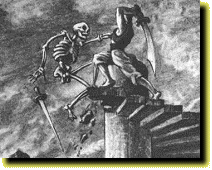 |
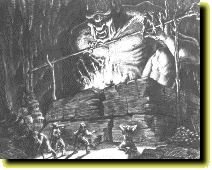 |
Harryhausen originally conceived another black and white project but Schneer would simply not allow it as he had for 20 MILLION MILES TO EARTH. 7TH VOYAGE OF SINBAD was going to be in color. The decision created more work for Ray, who after perfecting the animation process for black and white, would have to come up with a new technique for a color film. Essentially, the problem had to do with rear projection. Color film stock, when rear-projected loses much of the brilliance of the image. Ray pushed the limits for the film and the end results were spectacular.
Kenneth Kolb was brought in to write a storyline bringing the drawings together. The drawings involved a dragon battling a Cyclops, Sinbad discovering and old castle, and, most importantly, Sinbad battling a Skeleton on a spiral staircase. A Spanish film crew and supporting actors were hired for the project. This move to Spain proved to serve another advantage for Schneer. He managed to persuade a harbour master to allow them to use a recreation of Columbus' ship the SANTA MARIA as Sinbad's ship. This ship was used for several shots, most made during a time when Kerwin Mathews (Sinbad) became dreadfully ill.
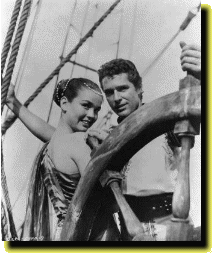 Mathews would later recall that
it was the first time for many of the American crew and actors in Spain and
that most of them got ill during production. He claims that while running
a 103 degree temperature, Charles Schneer came up to the hospital where he
was staying and asked him if he couldn't come down to the harbour for just
a few shots. While shooting some of the storm shots in the harbor, the Barcelona
fire Department was brought in to spray the ship with water attempting to
recreate the Wailing Siren sequence. The shots Schneer wanted Mathews for
included being sprayed by the fire department. Since Spain doesn't run into
the same problems with environmental groups, the water that was pumped from
the harbour was not the cleanest.
Mathews would later recall that
it was the first time for many of the American crew and actors in Spain and
that most of them got ill during production. He claims that while running
a 103 degree temperature, Charles Schneer came up to the hospital where he
was staying and asked him if he couldn't come down to the harbour for just
a few shots. While shooting some of the storm shots in the harbor, the Barcelona
fire Department was brought in to spray the ship with water attempting to
recreate the Wailing Siren sequence. The shots Schneer wanted Mathews for
included being sprayed by the fire department. Since Spain doesn't run into
the same problems with environmental groups, the water that was pumped from
the harbour was not the cleanest.
In spite of illness, Kerwin Mathews delivers a fine Sinbad. Mathews was a contract player for Columbia and he was among several young actors considered including Glenn Ford. Watching Mathews interact with Ray's creatures is almost as amazing as the creature themselves. It must be remembered that the actors have nothing to go on but their own imagination and a few reference points. Of all the actors in the Harryhausen films, Mathews manages to capture this quality the best, seeming to make eye contact with the creatures that aren't there for him. This is especially true when he interacts with the Princess when she is in her miniature state. His eyes always seem to follow her.
Ray's work was very different for this film since it involved more creatures. Up until now Ray's films all focused around one creature. 7th VOYAGE OF SINBAD required a CYCLOPS, a SERPENT WOMAN, a DRAGON, the TWO-HEADED ROCS (both Mama and Baby) and the SKELETON. It also required the shrinking of the Princess. Upon original consideration, the CYCLOPS was to be more human like in appearance but Ray decided to create a more animal- like lower half that could never be dismissed as an actor in a costume. There was also to be two different Cyclops who battle one another in the original draft but this was tossed out by budget limitations. Two different Cyclops do appear in the film, careful observers will note that the first Cyclops has one horn while the second has a smaller horn behind the larger one.
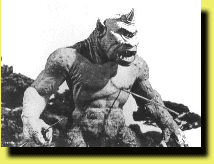 The Cyclops is the first creature to make an appearance and he does so in
the first few minutes of the film. As Sinbad and Crew arrive on the island
of Colossa, The Cyclops is pursuing Sokurah. As this action unfolds around
us the Cyclops is part of the action, moving in and around the actors. This
unique blending of stop-motion animation and live-action required a new name
for several reasons. Harryhausen once stated that he coined the term DYNAMATION
because the critics and reviews constantly referred to their films as animated
films and that people would confuse them as cartoons. He had hoped the term
DYNAMATION would clarify some of the confusion
The Cyclops is the first creature to make an appearance and he does so in
the first few minutes of the film. As Sinbad and Crew arrive on the island
of Colossa, The Cyclops is pursuing Sokurah. As this action unfolds around
us the Cyclops is part of the action, moving in and around the actors. This
unique blending of stop-motion animation and live-action required a new name
for several reasons. Harryhausen once stated that he coined the term DYNAMATION
because the critics and reviews constantly referred to their films as animated
films and that people would confuse them as cartoons. He had hoped the term
DYNAMATION would clarify some of the confusion
To assemble the CYCLOPS, Ray took his Ymir from 20 MILLION MILES TO EARTH apart to use the armature. Using a foam injecting process, he had to redo the Cyclops several times before he got one that was right. The lower half of the Cyclops body is covered by a rubberized fur. This was designed by George Lofgren. Lofgren had worked with Harryhausen on three of the previous films but was always uncredited. Many have speculated that Lofgren designed some of Ray creatures but before his death Lofgren himself denounced those rumors by declaring to stop-motion animator Jon Berg that the creations were Rays and Ray's alone.
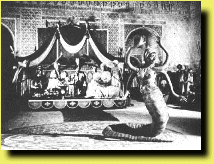 Turning Sardi into the SERPENT
WOMAN was the next effect witnessed in the film. This happens about 18 minutes
into the story. When the giant vase is broken away a stop-motion Sardi emerges
with rubbery arms and her entire lower portion is that of a serpent. She
performs a dance set to the stunning music of Bernard Herrmann. In recollection,
this scene is always remembered as being much longer than it actually is.
It is the impact of the scene and it's effectiveness that make us remember
the scene as lasting several minutes instead of less than one.
Turning Sardi into the SERPENT
WOMAN was the next effect witnessed in the film. This happens about 18 minutes
into the story. When the giant vase is broken away a stop-motion Sardi emerges
with rubbery arms and her entire lower portion is that of a serpent. She
performs a dance set to the stunning music of Bernard Herrmann. In recollection,
this scene is always remembered as being much longer than it actually is.
It is the impact of the scene and it's effectiveness that make us remember
the scene as lasting several minutes instead of less than one.
Harryhausen's next creature to appear on the screen is the baby 2-headed Roc. This creature was given a covering of duck down by Lofgren. During the shooting of this sequence, one of the most controversial events in Ray's life occurred. Ray allowed a young animator on the set to watch as he was filming this sequence. This 18-year-old watched intently as Ray committed these scenes to film. The young man turned out to be Jim Danforth. After leaving the set Danforth was hired to do the effects work on JACK THE GIANT KILLER and the Dynamation process which Ray had created was used. Critics of Harryhausen have long contended that Ray sealed his sets after this point out of anger. This is definitely not true.
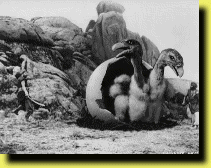 |
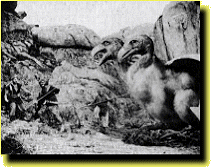 |
Ray, even while working on his own Mother Goose stories, worked in seclusion. He does this to avoid distraction so he can keep at the tedious work of stop-motion. A minor error in calculation can set a project back several days or weeks by requiring a re-shoot. In fact, by the time of the shooting of JACK THE GIANT KILLER an article appeared in ARGOSY magazine that included a lengthy interview with Ray where he described in detail, the process of DYNAMATION. Several magazines, like CINEMAFANTASTIQUE, have attempted to promote this myth about a rivalry between Ray and Danforth in several of their articles. Danforth, who in many interviews, appears to be somewhat bitter at the industry does not give the rumors any credit but he also doesn't appear to try and dispel them either. The real difference in the work of Danforth and Harryhausen lies not in the technique that puts the animated object on the screen, but the appearance of the objects themselves. A casual look at the giant in JACK and the CYCLOPS in SINBAD reveal the real separation between talented student and the teacher-a genius of technique, styling and creation.
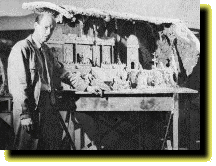 Ray
needed a massive miniature set for the interior shots of the cave. It
was very critical that this set would match the live sets and that the lighting
of the miniture sets equaled the lighting on the live sets. This set
included an extremely detailed exterior of Sokurah's castle which was
hidden deep inside the cave. Much of the action in the last third of
the film takes place in a near perfect blending of the miniature set and
the live action set. The interior of the cave was also home to one of the
screens most fearsome dragons.
Ray
needed a massive miniature set for the interior shots of the cave. It
was very critical that this set would match the live sets and that the lighting
of the miniture sets equaled the lighting on the live sets. This set
included an extremely detailed exterior of Sokurah's castle which was
hidden deep inside the cave. Much of the action in the last third of
the film takes place in a near perfect blending of the miniature set and
the live action set. The interior of the cave was also home to one of the
screens most fearsome dragons.
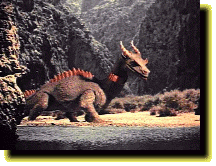 To call the dragon in THE 7TH VOYAGE
OF SINBAD amazing is an understatement. It is simply beautiful in it's
detail and sheer size. From the moment the dragon appears, Ray manages to
give this creature an awesome feeling of being real. It pulls on it's
chains struggling for freedom and breathes heavily. Each heaving sigh created
by the inclusion of an air bag inside the miniature model. Ray also
made the dragon a colorful creature with it's red tinted horned back and
it's bright green colors.
To call the dragon in THE 7TH VOYAGE
OF SINBAD amazing is an understatement. It is simply beautiful in it's
detail and sheer size. From the moment the dragon appears, Ray manages to
give this creature an awesome feeling of being real. It pulls on it's
chains struggling for freedom and breathes heavily. Each heaving sigh created
by the inclusion of an air bag inside the miniature model. Ray also
made the dragon a colorful creature with it's red tinted horned back and
it's bright green colors.
The shooting of the skeleton duel required the hiring of fencing master
Enzo Musumeci-Greco. The entire sequence was rehearsed with Enzo, painstakingly
working Mathews through each step like a meticulously choreographed dance
routine with an 8 step count. Each step, movement and swing of the sword
was staged and repeated over and over again until Mathews could perform the
routine without the fencing instructor. The whole sequence was shot in black
and white with Enzo and
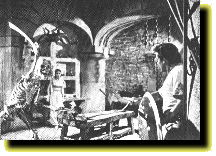 Kerwin
and this allowed a reference point for Harryhausen to stage the movements
of the skeleton using Musumeci-Greco as a character study. The sequence remains
the highest animated experience of the whole film. It is this sequence that
we quickly remember during the discussions of the film. It is so meticulously
planned and executed that it leaves us with that awe-inspired feeling of
"HOW DID THEY DO THAT!" And in those of use who were lucky enough to see
this film as a very young child, the fear that the damn thing just might
be for real. The Dragon and the Cyclops could never get in our bedrooms but
that hideous skeleton with the eternally evil smile could drop out of the
closet and there would be hell to pay. After all, how do you kill something
that is already dead? This sequence was deemed so disarming by the British
Censor board that it was cut from the print altogether. It was later restored
but it was YEARS later. It's hard to imagine watching this film without the
Skeleton Duel sequence.
Kerwin
and this allowed a reference point for Harryhausen to stage the movements
of the skeleton using Musumeci-Greco as a character study. The sequence remains
the highest animated experience of the whole film. It is this sequence that
we quickly remember during the discussions of the film. It is so meticulously
planned and executed that it leaves us with that awe-inspired feeling of
"HOW DID THEY DO THAT!" And in those of use who were lucky enough to see
this film as a very young child, the fear that the damn thing just might
be for real. The Dragon and the Cyclops could never get in our bedrooms but
that hideous skeleton with the eternally evil smile could drop out of the
closet and there would be hell to pay. After all, how do you kill something
that is already dead? This sequence was deemed so disarming by the British
Censor board that it was cut from the print altogether. It was later restored
but it was YEARS later. It's hard to imagine watching this film without the
Skeleton Duel sequence.
Another reason this sequence works so well is the Herrmann score. No discussion of this film is complete without mentioning the importance of the score. Harryhausen has always felt that this was the best score Herrmann gave to them in their 4 picture collaboration. Schneer knew Herrmann and asked him to attend a screening of the work print. Herrmann had the reputation of sitting through these screening and making rather rude observations of the film he was watching. During this screening Herrmann sat quietly through the entire film when it was finished simply stated that he thought he could do something for the picture. What he did was create the most impacting score of any fantasy film since Max Steiner and KING KONG. The score for this film is the perfect pairing of the two mediums and it is certainly a must have in any soundtrack collection.
You will often read the Ray Harryhausen was a director of "B" films. While this may have been true of the black and white films, it couldn't be further from the truth for this film or any of the others that followed. THE 7TH VOYAGE OF SINBAD was was budgeted at over $2 million, including promotion and advertising cost. Two million dollars was not "B" movie budget. Looking at budgets for much larger films like EXODUS and BRIDGE ON THE RIVER KWAI which were made with larger casts at under $4 million, you can not dismiss these films as "B" movies. THE 7TH VOYAGE OF SINBAD was released in 1958 and was promoted by Columbia pictures, the distribution company. By the time it had finished it's initial worldwide release is had netted $6 million, more than recouping it's initial cost. As an interesting side-note, THE 7TH VOYAGE OF SINBAD opened at the Roxy Theater in New York City. The owners of the Roxy had decided that they would screen one more film after John Ford's THE LAST HURRAH, and SINBAD was their picture. It proved to be so financially successful for them that the theater remained open for another 2 years. From this point on the Harryhausen/Schneer collaborations would reflect the episodic appearance and multi-creature cast that helped make Sinbad the success it was. For their next film they turned to the land of Lilliput and the pages of Jonathan Swift for THE 3 WORLDS OF GULLIVER.


| CAST AND CREDITS |
SYNOPSIS | BEHIND THE
SCENES |
| POSTERS | LOBBY
CARDS | IMAGES |
SKETCHES | SOUNDS
|
| 7TH VOYAGE
OF SINBAD STORE |


|
Profile
|
Filmography
|
Collectibles
|
Misc.
| King
Kong Event|

Please e-mail and let me know what you think. I'm open to any
comments or suggestion that you think would help this page.
 send email to Jim Rodkey.
send email to Jim Rodkey.
